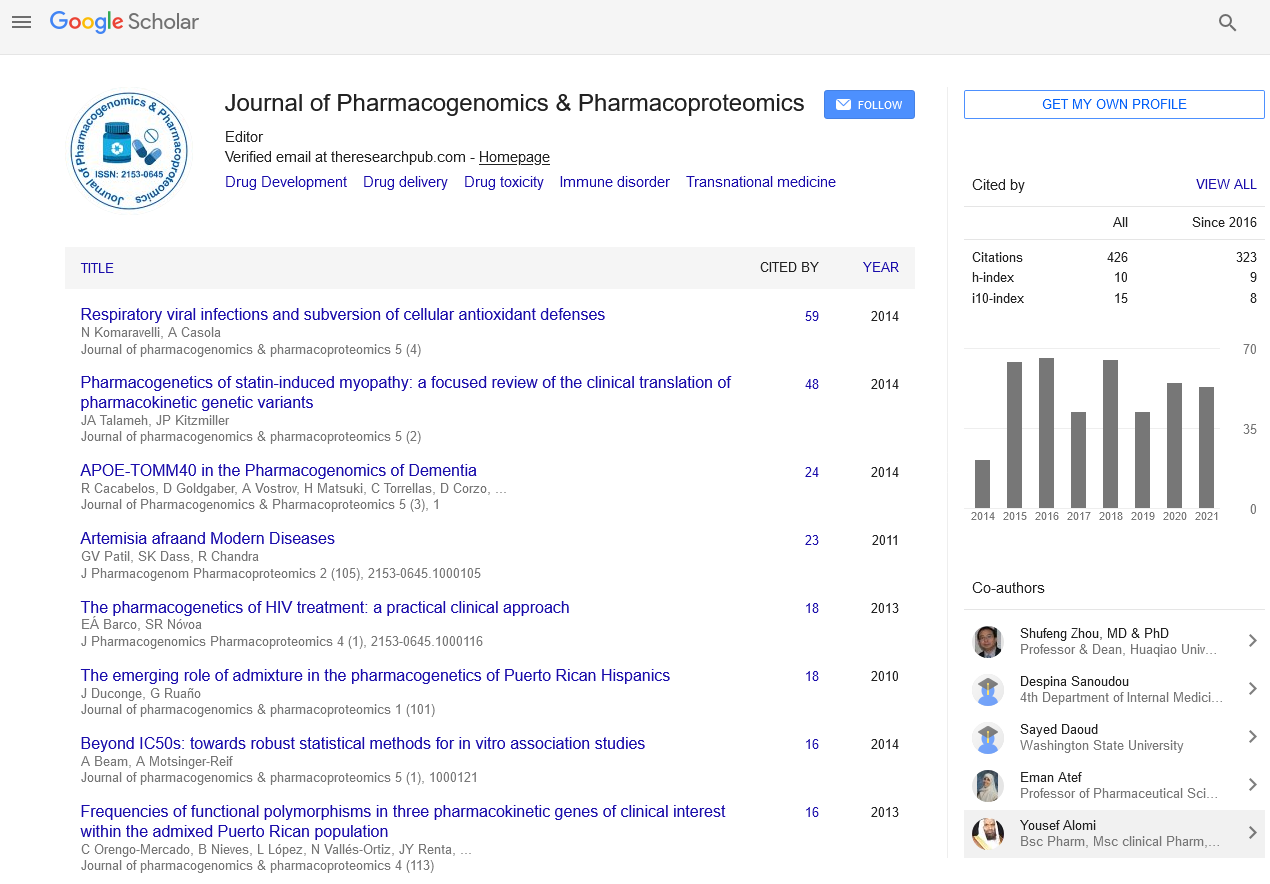Indexed In
- Open J Gate
- Genamics JournalSeek
- Academic Keys
- JournalTOCs
- ResearchBible
- Electronic Journals Library
- RefSeek
- Hamdard University
- EBSCO A-Z
- OCLC- WorldCat
- Proquest Summons
- SWB online catalog
- Virtual Library of Biology (vifabio)
- Publons
- MIAR
- Euro Pub
- Google Scholar
Useful Links
Share This Page
Journal Flyer

Open Access Journals
- Agri and Aquaculture
- Biochemistry
- Bioinformatics & Systems Biology
- Business & Management
- Chemistry
- Clinical Sciences
- Engineering
- Food & Nutrition
- General Science
- Genetics & Molecular Biology
- Immunology & Microbiology
- Medical Sciences
- Neuroscience & Psychology
- Nursing & Health Care
- Pharmaceutical Sciences
SNAP NAPPA Microarrays and mass spectrometry for personalized medicine and molecular diagnosis
2nd International Conference on Predictive, Preventive and Personalized Medicine & Molecular Diagnostics
November 03-05, 2014 Embassy Suites Las Vegas, USA
Evgeniya Peshkova and Claudio Nicolini
Scientific Tracks Abstracts: J Pharmacogenomics Pharmacoproteomics
Abstract:
Towards a new generation of Personalized Medicine an innovative self-assembling protein microarray, based on NAPPA and SNAP tag coupled to E. coli cell free expression system, is here introduced along with Matrix Assisted Laser Desorption Ionization Time-of-Flight (MALDI-TOF). This aims indeed to develop in clininical setting a standardized procedure to identify the leading protein-protein interaction in a given pathology towards the enhancement of both diagnosis and therapy. In the process we employ ?Protein synthesis Using Recombinant Elements? (PURE) system which due to its high complexity has required ad hoc bioinformatic tools. The PURE system represents a step towards a totally defined in vitro transcription/ translation system, thus avoiding the ?black box? nature of the cell extract. The immediate advantage is the E. coli IVTT that respect to the RRL or human lysate proved an advantage for the MS analysis of the results. The presence of ?background? molecules, in fact, represents the main obstacle to the MS data interpretation. For this latter reason SpADS: An R Script for Mass Spectrometry Data Preprocessing before Data Mining an ad hoc script was implemented. SpADS provides useful preprocessing functions such binning, peak extractions, spectra background subtraction and dataset managing. Moreover, in its final version, it is able to perform peak recognition and amplitude independent subtraction functions were implemented. The MS samples are obtained from SNAP-NAPPA spots printed on gold coated glass slides in higher density, in order to obtain an amount of protein appropriate for MS analysis. The spots of 300 microns were printed in 12 boxes, each box with 100 identical spots. The sample genes immobilized as test cases were p53_Human (Cellular tumor antigen p53); CDK2_Human (Cyclin-dependent kinase), 2;Src_Human-SH2 (the SH2 domain of Proto-oncogene tyrosine-protein kinase),, PTPN11 (Human-SH2, the SH2 domain of Tyrosine-protein phosphatase non-receptor type 11). This represents a proof of principles with optimization in progress.
Biography :
Evgeniya Peshkova is presently an Assistant Professor of Biochemistry and Biophysics at the University of Genova Medical School. After taking her Doctoral degree in Chemistry at Moscow State Lomonosov University in 1998, and the PhD in Biophysics at University of Genova in 2003, was Scientific Director of Fondazione ELBA (Electronic Biotechnology Advanced) and Principle Investigator of a big FIRB research grant on Organic Nanotechnology. Later she acquired the scientific responsibility of the laboratory of Nanobiocrystallography at the Nanoworld Institute, University of Genova. In 2007 she worked as a Visiting Scientist at the European Synchrotron Radiation Facility (ESRF) in Grenoble in Macromolecular Crystallography and Soft Condensed Matter, remaining up to now one of the PI of Radiation Damage BAG. She is author of more than 50 international scientific publications (ISI-SCI), 2 patents, several chapters to books and textbooks. Her main scientific interests are structural proteomics, functional nanoproteomics and nanocrystallography


